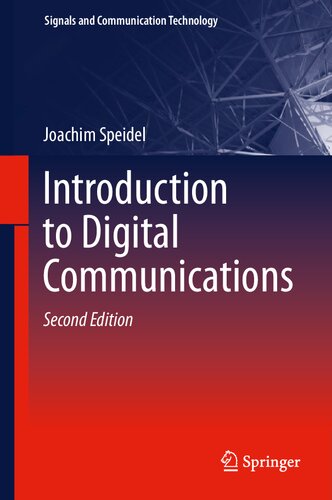

Most ebook files are in PDF format, so you can easily read them using various software such as Foxit Reader or directly on the Google Chrome browser.
Some ebook files are released by publishers in other formats such as .awz, .mobi, .epub, .fb2, etc. You may need to install specific software to read these formats on mobile/PC, such as Calibre.
Please read the tutorial at this link. https://ebooknice.com/page/post?id=faq
We offer FREE conversion to the popular formats you request; however, this may take some time. Therefore, right after payment, please email us, and we will try to provide the service as quickly as possible.
For some exceptional file formats or broken links (if any), please refrain from opening any disputes. Instead, email us first, and we will try to assist within a maximum of 6 hours.
EbookNice Team

Status:
Available4.5
30 reviewsThis book offers students, scientists, and engineers an extensive introduction to the theoretical fundamentals of digital communications, covering single-input single-output (SISO), multiple-input multiple-output (MIMO), and time-variant systems. Further, the main content is supplemented by a wealth of representative examples and computer simulations.
The book is divided into three parts, the first of which addresses the principles of wire-line and wireless digital transmission over SISO links. Digital modulation, intersymbol interference, and various detection methods are discussed; models for realistic time-variant, wireless channels are introduced; and the equivalent time-variant baseband system model is derived. This book covers two new topics such as blockwise signal transmission and multicarrier modulation with orthogonal frequency-division multiplexing (OFDM) systems.
Since not all readers may be familiar with this topic, Part II is devoted to the theory of linear time-variant systems. The generalized convolution is derived, and readers are introduced to impulse response, the delay spread function, and system functions in the frequency domain. In addition, randomly changing systems are discussed. Several new examples and graphs have been added to this book.
In turn, Part III deals with MIMO systems. It describes MIMO channel models with and without spatial correlation, including the Kronecker model. Both linear and nonlinear MIMO receivers are investigated. The question of how many bits per channel use can be transmitted is answered, and maximizing channel capacity is addressed. Principles of space–time coding are outlined in order to improve transmission quality and increase data rates. In closing, the book describes multi-user MIMO schemes, which reduce interference when multiple users in the same area transmit their signals in the same time slots and frequency bands.